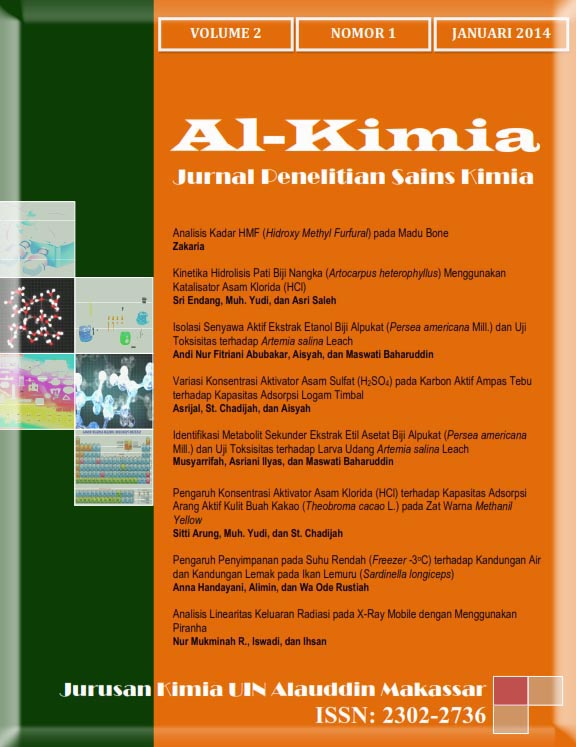Pengaruh Konsentrasi Aktivator Asam Klorida (HCl) Terhadap Kapasitas Adsorpsi Arang Aktif Kulit Buah Kakao (Theobroma cacao. L) Pada Zat Warna Methanil Yellow
Abstract
Cocoa’s peel is a waste which usually burned, stacked or disintegrated and can make pollution to the environment. This condition motivates the researcher to produce the value-added product from the cocoa’s peel, such as activated carbon and as well as it can solve the environmental problems. This research aims to know the influence to use variation of concentration of activator HCl whice produces the optimum adsorption capacity from charcoal active of cocoa’s peel to the substance color of methanil yellow. Active carbon which is used in this research comes from cocoa’s peel which granular types with standard -100+40 mesh. Carbon is activated by physics in furnace with 600°C heat during 2 hours and is activated by chemistry with submerged of HCI 1M, 2M, 3M, 4M and 5M during 24 hours. The result of this research shows that optimum concentration in HCI 1M with adsorption capacity from charcoal active of cocoa’s peel is as large as 1,572 mg/g. Whereas knowing the influence of activator is used tabulation method by statistically, where we can get FHitung 0,003 is smaller from FTabel 10,127. It explains that H0 is accepted to reject H1. Therefore, it can conclude that there is not significant influence to use variation of concentration of activator HCl to adsorption capacity of charcoal active from cocoa’s peel in substance methanil yellow.
Downloads
References
Jufri, A. I., 2009, “Kapasitas Adsorpsi Karbon Aktif Kulit Buah Kakao (Theobroma cacao L.) Terhadap Zat Warna Rhodamin B”, Skripsi Sarjana, Makassar: Fakultas Matematika dan Ilmu Pengetahuan Alam UNM Makassar.
Sitohang,dkk., 2009, “Pemanfaatan Limbah Sekam Padi menjadi Arang Aktif sebagai Adsorben”,Jurnal PKM, online, Institut Pertanian Bogor, Bogor, http://repository.IPB.Ac.id, diakses 23 Januari 2013.
Atkins PW., 1999, Kimia Fisika Jilid II. Kartohadiprodjo II, Penerjemah; Rohhadyan T, editor. Oxford: Oxford University Press. Terjemahan dari: Physical Chemistry.
Suhendra, D., 2010, ”Pembuatan Arang Aktif dari Batang Jagung Menggunakan Aktivator Asam Sulfat pada Penyerapan Ion Tembaga (Cu)”, online, http//www.wordpress.com, diakses 23 Maret 2013.
Hapid, D., 2013, “Kapasitas Adsorpsi Pasir Silika Terhadap Zat Warna Rhodamin B.”, Skripsi Sarjana, Makassar: Fakultas Matematika dan Ilmu Pengetahuan Alam UNM Makassar.
Fitriawati, E., Kapasitas Adsorpsi Khitosan Terhadap Rhodamin B, online, http//www.wordpress.com, diakses 23 Februari 2013.
Fessenden RJ dan Fessenden JS, 1986, Kimia Organik Jilid 1 Edisi ke-3. Penerjemah; Pudjaatmaka AH. Jakarta: Erlangga. Terjemahan dari: Organic Chemistry.
Hendayana, 1990, Kimia Analitik Instrumen. Bandung: Fakultas MIPA IKIP.
Authors who publish with this journal agree to the following terms:
1) Authors retain copyright and grant the journal right of first publication with the work simultaneously licensed under a Creative Commons Attribution License that allows others to share the work with an acknowledgement of the work's authorship and initial publication in this journal.
2) Authors are able to enter into separate, additional contractual arrangements for the non-exclusive distribution of the journal's published version of the work (e.g., post it to an institutional repository or publish it in a book), with an acknowledgement of its initial publication in this journal.
3)Authors are permitted and encouraged to post their work online (e.g., in institutional repositories or on their website) prior to and during the submission process, as it can lead to productive exchanges, as well as earlier and greater citation of published work (See The Effect of Open Access).


